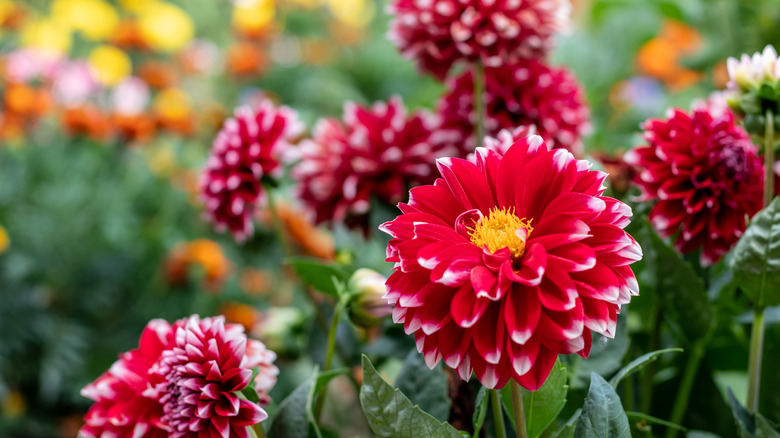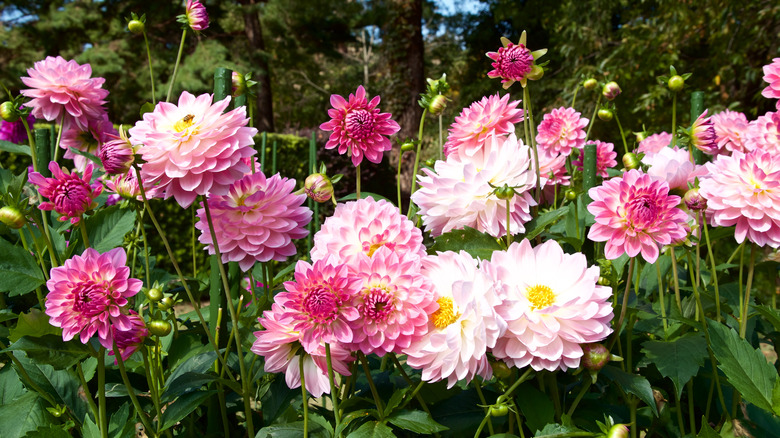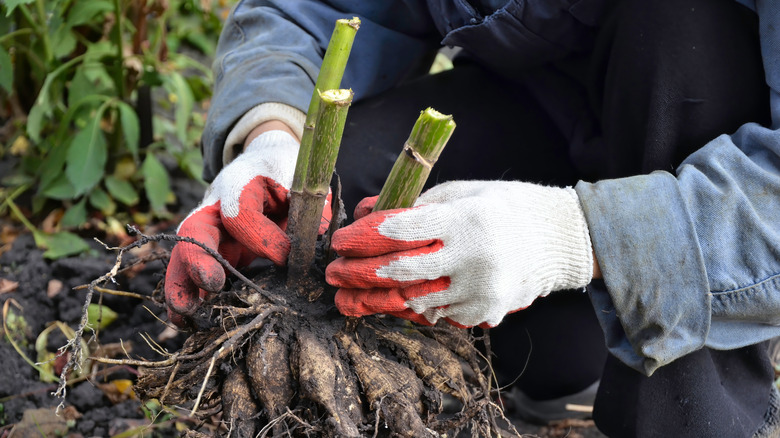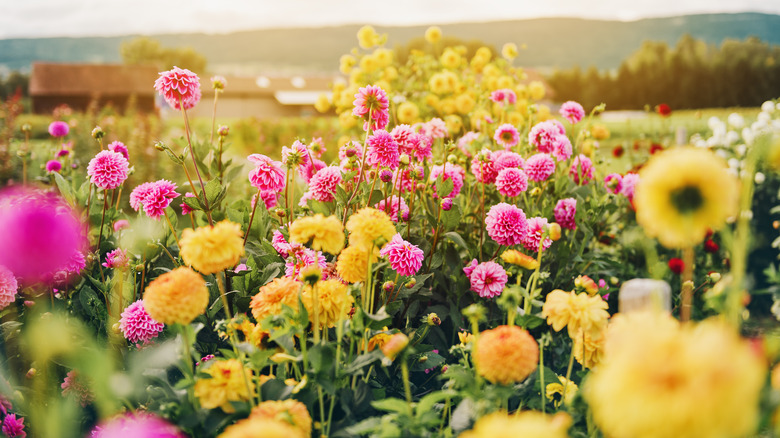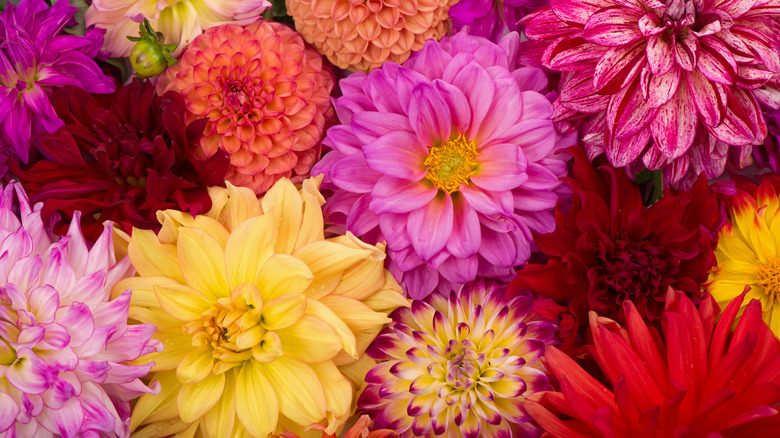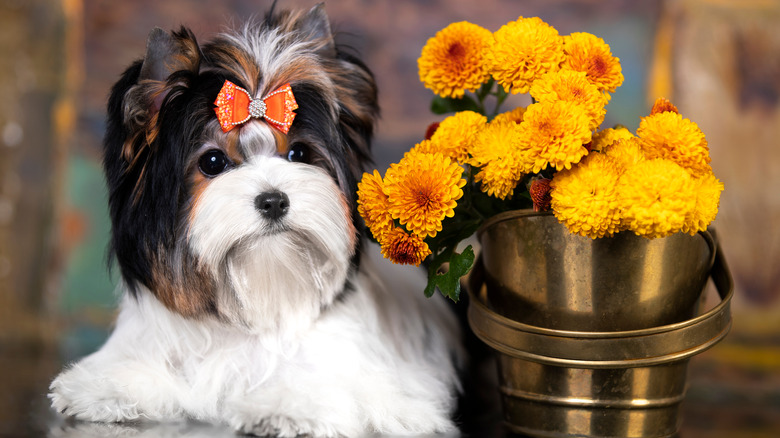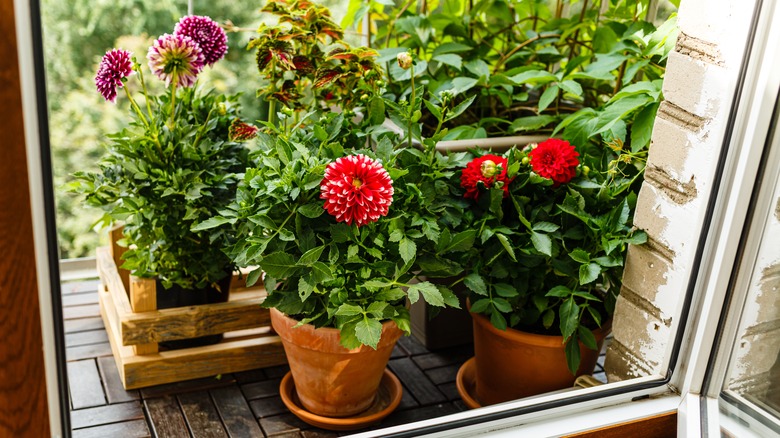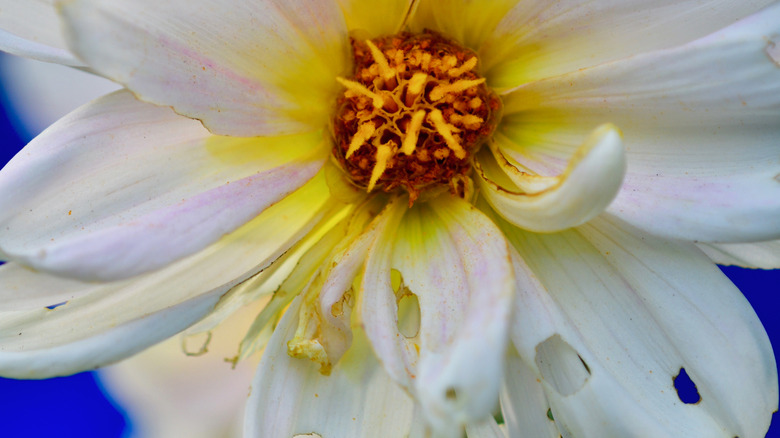Dahlia: Everything You Need To Know Before Planting
Dahlias (scientific name: Dahlia) are a perennial flowering plant, marked by thick, fluffy blooms that come in a variety of colors, ranging from red to white, purple, pink, and peach. The petals are typically curved in appearance, although some feature more of a pointed rather than rounded tip, as per Names of Flowers. The plant also comes in a wide range of sizes, from 1 to 6 feet in height and featuring blooms from 2 to 12 inches in diameter.
While dahlias are typically grown today for their beauty and color, they were originally used for medicinal and food purposes in their native region of Central America and Mexico, according to Gardening Know How. The Aztec people, in particular, sought the dahlia tubers for their high-energy carbohydrates as well as for antibiotics for injuries and infections. Dahlias only spread to the rest of the world following the Spanish invasion of these territories, but soon became a garden favorite for many.
It's hard not to enjoy the easy-to-grow nature of this bush-like plant, which rewards growers with long-lasting and vibrant blooms that grow from mid-summer through fall. Dahlias don't require multiple growing seasons to reach maturity either — they bloom right in the first growing season. They are also a popular cutting flower, providing pops of color in your garden and in your home. Keep scrolling for all you need to know about growing and caring for this stunning plant.
How to use dahlias in garden
Since dahlias have a late blooming season, they are the perfect flower to grow among early-blooming plants in your garden. This will extend the amount of time you can enjoy a yard full of colorful blooms by ensuring that there is always something growing. Garden Design points out another benefit to growing dahlias among other plants as opposed to on their own: The most attractive parts of the dahlia are the upper stalks and the flowers. Hiding the base of the stalks among other plants allows this beautiful top part to shine through. Ornamental grasses work great for this reason while also pairing nicely with dahlias to provide contrast. Additionally, you may want to consider growing your dahlias along stakes to prevent them from bending over under the weight of their heavy blooms.
The location you choose for your dahlias will also depend on the size of the variety. Larger varieties will look great planted in the back of a garden bed or along a fence or other barrier in your garden while smaller varieties will thrive in the front of larger plants. If you lack space for beds in your garden but still want to enjoy the colorful blooms, try planting your dahlias in containers. The mobility of this option allows you to transport your dahlias to various places in your yard depending on the time of year. You can also keep the containers on a deck or balcony.
How to grow dahlias
Dahlias are grown from tubers, which sit underground. They can only be planted once the last frost of the season has passed in the spring, although this depends on the region in which you live. If you live in a warmer climate, you can plant earlier in the spring, while colder climates may require you to wait until closer to summer to achieve the soil temperatures necessary for dahlias to thrive — about 60 degrees Fahrenheit, as per American Meadows. In the latter case, you may want to consider planting your dahlia tubers in containers indoors about a month ahead of time to give them the chance to bloom during the growing season.
Once you have the number of tubers you want to grow, you'll need to dig holes between 4 and 6 inches deep, depending on the size of the tuber, according to Floret. You should provide a 1-foot radius around each hole to ensure your dahlias have enough room to spread out in the soil. Once you lay the tuber horizontally in the hole with the eye pointing upward, cover with soil. Depending on the variety of dahlia, you may also need to put a stake in the hole alongside the tuber for the plant to climb as it grows to avoid toppling over. Note that you will need to refrain from watering your dahlias until you see green growth emerging from the soil. After that, water generously through the summer.
How to care for dahlias
While dahlias are not fussy growers, there are a few key conditions you'll need to provide to ensure they thrive in your garden. The quality of the soil is one of the major areas that you'll need to pay attention to. It should have a fairly neutral pH level and allow for proper drainage to ensure the roots of the plant are never sitting in stagnant water, as per The Spruce. You will also need to provide a layer of mulch for some extra nutrients and to prevent weeds from growing around the base of the plant and impacting its growth. Before you plant your dahlias, take care to note which areas of your garden receive the most sun as dahlias need direct sunlight for the majority of the day. A bit of shade won't harm them, however, especially in hotter regions.
It's also important to strike the proper balance between giving too much and too little water. The soil should never be bone dry between waterings, nor should it ever be water logged as this will lead to root rot. You can shoot for watering a couple times a week once growth has emerged from the ground. Keep in mind that this may need to be adjusted based on rainfall and climate. For bigger and more beautiful blooms, keep a bag of fertilizer on hand to use during the growing season — just make sure it isn't too high in nitrogen.
Varieties of dahlias
Dahlias hail from Central America and Mexico and boast thousands of different varieties, 42 of which are sub-species, while the rest are hybrids, according to Gardening Know How. The scientific name for this plant is also Dahlia, although the individual species carry an additional designation. While growing conditions don't differ too much from species to species, the main differences are found in the appearance of the varieties. Dahlias come in a multitude of sizes and flower forms while petals can vary drastically in size and shape. The largest blooms can reach a foot in diameter while miniature varieties feature 1-inch blooms. This dizzying variety ensures that there are plenty of colors and styles to match anyone's taste.
Among the many varieties is the Dahlia Dutch Explosion, which is characterized as a cactus variety due to the pointed appearance of its petals, as per Gardenia. The flower also features a bold magenta hue mixed with white. Another variety is the Dahlia Frigoulet, marked by long, skinny petals that are bright-red in color with a white tip. The Dahlia David Howard is perfect for anyone who prefers the popular "pom-pom" style of dahlia, notable for its peach-colored petals and fluffy appearance. The Dahlia Night Butterfly is as unique as they come with two layers of petals. The bottom layer consists of wide, dark-maroon petals while the top petals are short and thin. Finally, the Dinnerplate Dahlia Seattle features beautiful white-and-yellow layered blooms that reach 8 inches in diameter.
Are dahlias toxic?
You'll be happy to learn that dahlias are not toxic to humans, as per ProGarden Tips. In fact, the tubers of this plant were traditionally used in food and medicine before they became a decorative plant. That being said, if you choose to ingest dahlias, you will want to avoid excessive consumption. For some, a chemical known as phototoxic polyacetylene, which is located within the leaves and tubers, can irritate the skin as well. If this happens, simply wash with warm water and soap.
Unfortunately, while not toxic to humans, dahlias are a potentially toxic flower to dogs and cats, according to Michelson Found Animals. Accidental ingestion may lead to symptoms of gastrointestinal distress that range from vomiting to diarrhea and general stomach upset. If you believe your pet has ingested any part of the dahlia plant and/or is showing signs of toxicity, always contact your nearest emergency veterinary center for assistance.
Being a pet parent doesn't mean you have to get rid of your dahlias, however. There are ways you can protect your pets from this plant while still getting to enjoy its beautiful blooms in your garden. For starters, try sectioning off the part of your garden where you've planted your dahlias to keep your pets out. You can also restrict your dahlias to containers, which will allow you to put them up out of reach. Another option is to train your pet using positive reinforcement techniques to leave your dahlias in peace.
How to repot dahlias
Since dahlias come in such a wide range of sizes, you will need to make sure you choose a smaller variety if you'd like to plant them in a pot or container. If not, your dahlias will become too restricted and die. Additionally, the only reason you'll need to repot your dahlia is if it has outgrown its current container. You can tell by looking at the drainage holes of the current pot — if the roots are growing out of the holes, this is a sign your dahlia is ready for a bigger home. Another way to know whether it's time to repot is if the plant becomes excessively large for the container its in or if it starts to die back after reaching a certain size.
Repotting should take place in the spring, as per Blooming Backyard. You'll need to purchase a pot or container with adequate drainage holes. It should also be the next size up from the previous container. Start by filling the container about 1/3 full with a quality potting soil that drains well. Gently remove your dahlia from the first pot and shake off any excess soil. Then place it on top of the potting mix in the new container. Fill in the rest of the pot with soil and give the plant some water. Just like with garden-planted dahlias, you can add a dose of fertilizer and keep the container in a sunny location to ensure proper growth.
Dahlia pests and diseases
Dahlias are a popular food source for many garden pests, including earwigs, spider mites, thrips, and caterpillars, as per Gardening Know How. Some of these pests will cause more damage than others, but all should be carefully controlled to ensure the survival of your dahlias. You should always take preventative measures to keep pests away, including not over- or under-watering your dahlias, making sure you regularly provide fertilizer, and clearing away dead or decomposing organic matter from the base of the plants. If you do find yourself with a pest problem, you can try getting rid of them by hand in the case of larger insects or use an insecticide spray to kill them off.
There are also a number of diseases that can prove detrimental to your dahlias, most of which are caused by viral or fungal infections, according to Gardening Know How. One of the most common is root rot, which is caused by excessive watering. To treat this, pull up your dahlias and replant them in well-draining soil, taking care not to overwater in the future. Another dahlia-targeting disease is verticillium wilt, which is caused by a fungus that attacks the leaves of the plant. You will need to dispose of infected plants and use a fungicide to treat the soil around the affected area. Solarization is another solution, which involves using sunlight to heat up the soil to temperatures that the fungi cannot withstand, as per Gardening Know How.
